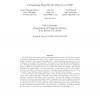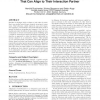1826 search results - page 276 / 366 » Using Random Forests in the Structured Language Model |
115
click to vote
PADL
2012
Springer
13 years 5 months ago
2012
Springer
We begin with a functional reactive programming (FRP) model in which every program is viewed as a signal function that converts a stream of input values into a stream of output va...
COMPUTER
2002
14 years 9 months ago
2002
rs use models or abstractions that hide low-level implementation details. Various kinds of representations such as data models, state-transition models, and dataflow models can hel...
186
click to vote
POPL
2006
ACM
15 years 10 months ago
2006
ACM
The movement to multi-core processors increases the need for simpler, more robust parallel programming models. Atomic sections have been widely recognized for their ease of use. T...
EDBTW
2004
Springer
15 years 3 months ago
2004
Springer
Many users and applications require the integration of semi-structured data from autonomous, heterogeneous Web sources. Over the last years mediator systems have emerged that use d...
ATAL
2010
Springer
14 years 11 months ago
2010
Springer
Speakers in dialogue tend to adapt to each other by starting to use similar lexical items, syntactic structures, or gestures. This behaviour, called alignment, may serve important...


